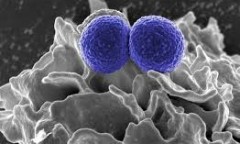By Vishal Goel, | November 20, 2016

The new photoreceptor is a protein called LITE-1. (YouTube)
A team of scientists has discovered a new type of photoreceptor that is about 50 times more efficient at capturing light than the human eye.
The new photoreceptor is a protein called LITE-1. It was found among a family of taste receptors in nematodes, a family of eyeless and millimeter-long roundworms that are common model organisms in bioscience research.
Like Us on Facebook
LITE-1 belongs to a family of taste receptor proteins which were first discovered in insects. "These, however, are not the same taste receptors as in mammals," said Shawn Xu, a professor in the Department of Molecular and Integrative Physiology at the U-M Medical School.
Xu's lab had previously demonstrated that the eyeless worms surprisingly move away from flashes of light. The discovery of LITE-1 has answered many questions by showing that it directly absorbs light instead of being an intermediary that senses chemicals produced by reactions involving light.
LITE-1 exhibits unusual characteristics such as being extremely efficient at absorbing both UV-A and UV-B light. LITE-1 is the third kind of photoreceptor which is superior to rhodopsin in the human eye. In fact, it is 10 to 100 times greater than the two other types found in the animal kingdom: opsins and cryptochromes. "The next step is to better understand why it has these amazing properties.", said Xu.
The discovery might prove useful in a variety of ways, according to the team of researchers led by the University of Michigan in the journal Cell. It might be possible, for instance, to develop LITE-1 into a sunscreen additive that absorbs harmful rays, or to further conduct scientific research to foster light sensitivity in new types of cells.
Animal photoreceptors typically have two components: a base protein and a light-absorbing chromophore (a role played by retinal, or vitamin A, in human sight). When these photoreceptors are broken apart, the chromophore still retains some of its functionality. But LITE-1 seemingly works on a very different model. Breaking it apart, or "denaturing" it, completely stops its ability to absorb light, rather than just diminishing it. The researchers also found that having the amino acid tryptophan in two places within the protein was critical to its function, according to Phys.
"This suggests scientists may be able to use similar techniques to genetically engineer other new photoreceptors," Xu said.
-
Use of Coronavirus Pandemic Drones Raises Privacy Concerns: Drones Spread Fear, Local Officials Say

-
Coronavirus Hampers The Delivery Of Lockheed Martin F-35 Stealth Fighters For 2020

-
Instagram Speeds Up Plans to Add Account Memorialization Feature Due to COVID-19 Deaths

-
NASA: Perseverance Plans to Bring 'Mars Rock' to Earth in 2031

-
600 Dead And 3,000 In The Hospital as Iranians Believed Drinking High-Concentrations of Alcohol Can Cure The Coronavirus

-
600 Dead And 3,000 In The Hospital as Iranians Believed Drinking High-Concentrations of Alcohol Can Cure The Coronavirus

-
COVID-19: Doctors, Nurses Use Virtual Reality to Learn New Skills in Treating Coronavirus Patients











